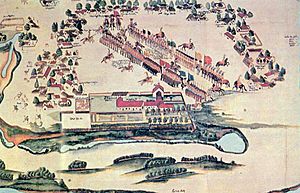Battle of Mbororé facts for kids
The Battle of Mbororé was a big fight between the Guaraní people, who lived in special towns called Jesuit Missions, and groups of explorers and adventurers known as bandeirantes. These bandeirantes came from a city called São Paulo. The battle happened on March 11, 1641, near a mountain called Mbororé. Today, this area is the town of Panambí in Misiones Province, Argentina.
Contents
Why the Battle Happened
The Need for Workers and the 'Bandeirantes'
In the early 1600s, the Dutch arrived on the coast of Brazil. They started attacking ships, which made it hard for the Portuguese to bring enslaved people from Africa. The Portuguese needed many workers for their sugar farms and cattle ranches in Brazil.
Because of this problem, Portuguese plantation owners started looking for workers among the local Indigenous people. Also, not much gold or silver was found near São Paulo. So, explorers began to travel deeper into Brazil.
These groups of explorers and slave hunters were called bandeiras. They were like businesses run by important people in São Paulo. Their groups included people of mixed Portuguese and Indigenous heritage (called Mamluks), Indigenous Tupi people, and even some Dutch adventurers. They had support from some Spanish and Paraguayan officials.
As they moved west, these bandeirantes helped Portugal expand its territory. This expansion became even more important when Portugal gained independence from Spain.
First Attacks on the Jesuit Missions
In 1608, the governor of Asuncion, Paraguay, Hernando Arias de Saavedra, asked the Jesuits to build towns and teach Christianity to the native people. These towns were in areas around the Parana River, Guayrá, and other regions.
The Jesuits started this work, and at first, the bandeirantes respected the Indigenous people in these Jesuit towns. However, the Guarani people in these towns were skilled workers. They were also defenseless because a rule said they couldn't carry weapons.
Around 1620, the bandeirantes' attacks became much more aggressive. They forced some villages to be abandoned or moved.
Between 1628 and 1631, bandeirante leaders like Raposo Tavares and Manuel Antonio Pires Preto attacked Guayrá many times. They captured thousands of Guarani people and sold them in São Paulo. It's thought that between 1628 and 1629, about 5,000 Indigenous people were captured. But only about 1,200 of them made it to São Paulo. Most died on the journey because of how they were treated.
By 1632, about 12,000 Guarani had been forced to move south. This left the Guayrá region almost empty. Other nearby areas also lost many people.
The bandeirantes kept moving west. They attacked Itatin in 1632. Then they moved to Tape, which was invaded between 1636 and 1638 by more bandeiras led by Raposo Tavares, André Fernandes, and Fernando Dias Pais.
The Jesuits Prepare to Fight Back
Montoya's Trip to the King
In 1638, two priests, Antonio Ruiz de Montoya and Francisco Diaz Tano, traveled all the way to Spain. They wanted to tell King Felipe IV about the attacks on the missions. They asked the King to allow the native people to use firearms to defend themselves.
The King and his advisors agreed with Ruiz de Montoya's ideas. They sent orders to Paraguay. A special order on May 12, 1640, said the Guaraní could have firearms for defense. But this had to be approved by the Viceroy of Peru. The priests went to Lima to get weapons for the native people. Meanwhile, Father Tano went to Rome to tell the Pope about the slave-hunting. He hoped the Pope would offer protection.
First Fight: The Apostles of Caazapaguazú
While waiting for the King's orders, the local priest, Diego de Boroa, saw that the bandeirantes were getting dangerously close to the Uruguay River. With permission from the Governor of Asuncion, he decided that the mission troops should get firearms and start military training. Eleven Spanish men were sent from Buenos Aires to help organize these defense forces.
In late 1638, Father Diego de Alfaro crossed the Uruguay River with some Guarani. They were armed and trained. Their goal was to take back their land and face the bandeirantes in the region.
After a few small fights, Father Alfaro's troops joined with Father Romero and 1,500 Guarani. They formed an army of 4,000 missionaries. They marched to a damaged mission town called Apostles Caazapaguazú. The bandeirantes were hiding there after losing some earlier fights. This battle was the first major victory for the Guarani over the Paulistas (people from São Paulo). The Paulistas quickly ran away after giving up.
São Paulo Plans a Counterattack
After their defeat, the bandeirantes went back to São Paulo to tell the authorities what happened.
Around the same time, Father Tano arrived in Rio de Janeiro from Madrid and Rome. He brought news of the King's orders and the Pope's support for the missions.
These two events made the government of São Paulo very angry. They worked with the plantation owners and kicked the Jesuits out of the city. São Paulo then organized a huge bandeira. It included 450 Dutch and Portuguese men with rifles and muskets, 700 canoes, and 2,700 Tupi archers. Manuel Pires led this large group. Their plan was to attack and destroy everything along the Uruguay and Paraná Rivers and capture all the people they could enslave.
See also
 In Spanish: Batalla de Mbororé para niños
In Spanish: Batalla de Mbororé para niños


